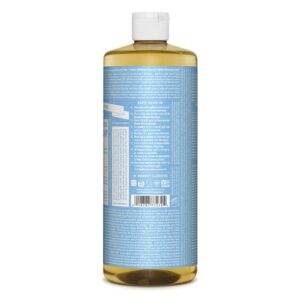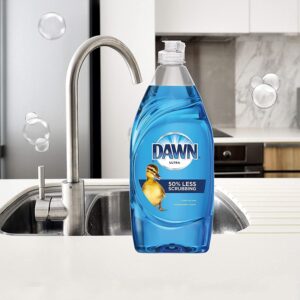One way to prevent cat-related infections is maintaining a good standard of hygiene on the pet. Some cats, such as Sphynx, have very oily skin. Such cat breeds require weekly or biweekly bathing.
Regular cat grooming gives the animal a healthy coat and skin. But what can you use to wash your cat? Read on for the range of soaps, shampoos, and other items to use in bathing your cat.
What Can I Use to Wash My Cat?
The best soap for washing your cat is cat-recommended shampoo. A cat shampoo is skin-friendly and does not irritate.
But if you run out of cat shampoo, what’s the next best alternative?
Don’t trust every shampoo or soap you find around. A cat’s skin is very delicate and some cleaning detergents may cause a high level of discomfort to pets.
The following are the cat shampoo alternatives to consider when bathing a cat.
Note: we make a small commission at no extra cost to you, if you make a purchase through links on this page.
Baby Shampoo
Infants do have delicate skins. And therefore, baby shampoo has skin-friendly ingredients. On the other hand, a cat’s skin is also sensitive.
So, you can use baby shampoo to clean your cat. However, it’s wise to use only baby shampoos that have no fragrances and are tearless.
A viable example to consider is Johnson’s tear-free baby shampoo. But don’t make it your permanent replacement for cat shampoo.
For the best method of applying the shampoo, rub it on your hands and massage it on the cat’s coat. Alternatively, you can dilute the shampoo in bathing water and follow the usual bathing procedure.
Castile Soap
 Fragrance-free castile soap has natural ingredients, is nontoxic, and matches delicate skin. That is why it can blend with the cat’s skin. Usually, it taps on coconut, hemp, or castor oil.
Fragrance-free castile soap has natural ingredients, is nontoxic, and matches delicate skin. That is why it can blend with the cat’s skin. Usually, it taps on coconut, hemp, or castor oil.
Following such a formulation, castile soap has a hydrating effect on the skin. Before using it, dilute the soap to a mild or high concentration.
You can prepare high shampoo concentration by adding one tablespoon of Castile liquid soap to every cup of water. On the other hand, you can achieve mild castile soap and water concentration by using a ratio of 1:10.
Besides settling on fragrance-free Castile, you must rinse your pet thoroughly after bathing with soap.
Baking Soda
Baking soda is an efficient cleaning detergent around the home. It helps eliminate odors and bacteria. Besides being easy to find, it removes oil and dirt. Also, it gives your pet a pleasant fragrance.
You only need about a three-quarter tablespoon of baking soda. Sprinkle and massage it on the cat’s coat. Leave it for a couple of minutes before brushing it away.
A towel can then help you remove traces of baking soda from your feline friend. But don’t let the baking soda reach the eyes.
Note that baking soda isn’t as effective as an immersive bath. Also, it can not clean out the oil and grease.
Pet and Baby Wipes
If spot cleaning is what you desire for your cat, then baby or pet wipes are an option to consider trying. But not all baby wipes have safe ingredients. Thus, use wet wipes or pet wipes that are fragrant-free.
Wipes can’t compare to an immersive bath. But for the cat that’s nervous about water or has a few spots of stains, wipes will suffice.
At the same time, wiping makes cleaning the ears, eyes, and paws trouble-free.
Oatmeal DIY Shampoo
A DIY oatmeal shampoo has no chemical additives and thus presents a gentle formulation. In addition, it’s an all-purpose shampoo that’s human-skin friendly.
The simplest way to make an oatmeal shampoo is to mix 4 cups of warm water with a cup of fine oatmeal.
Spray the solution on the cat and allow it to settle for about 5 minutes. Then rinse the pet thoroughly. One of the chief benefits of oatmeal shampoo is that it unclogs pores and awards the fur an extra soft feeling texture.
Vinegar and Water
By default, vinegar repels ticks, and fleas and eliminates odors. Also, it’s a natural cleaner that’s easy to find at home. For best results, use either apple cider or distilled white vinegar.
You can’t use vinegar to wash your cat in its concentrated form. Instead, pour half a cup of vinegar into a bathtub full of water and mix.
Vinegar has an overpowering smell, so don’t let the vinegar solution reach the cat’s face.
Dry Shampoo
You can also use the combination of ½ cup of cornmeal, ½ cup of oatmeal, and two tablespoons of cornstarch as a dry shampoo for your cat. The blend of those three substances awards the pet triple benefits:
- Deodorizes
- Detangles
- Reduces oil on the fur
Fine cornstarch, cornmeal, and oatmeal mixture is valuable for cats with dry skin types. In addition, you can replace cornmeal with rice flour, semolina, or fine flaxseed.
Sprinkle and leave the dry shampoo on the pet coat for about 5 minutes. Finish by brushing off the cat.
 Dawn Dish Soap
Dawn Dish Soap
Some rescue centers for animals employ dawn dish soap to clean out oily coats of animals. So, it’s safer on a cat’s coat than on a human shampoo.
Begin by mixing ¼ cup of dawn liquid soap, ½ cup of apple cider vinegar, and 2 cups of water. The such shampoo produces foam easily and is straightforward to apply on the pet.
But like all other shampoos, you must remove all traces of the soap from the pet.
Cornstarch
A simple dry shampoo that you can use to wash your cat is cornstarch. Besides being natural, cornstarch is simple to apply.
Start by sprinkling the cornstarch on the pet’s coat. Using your hands, massage the cat for the cornstarch to penetrate the fur.
Let it stay on the pet’s fur for a couple of minutes before brushing it off.
Conclusion
Most human shampoos are not compatible with cats. Furthermore, shampoos with fragrances aren’t also safe for animals.
So consider using easy-to-find items such as baby shampoo, baking soda, and vinegar. When in doubt about what to use, contact a vet for advice.

